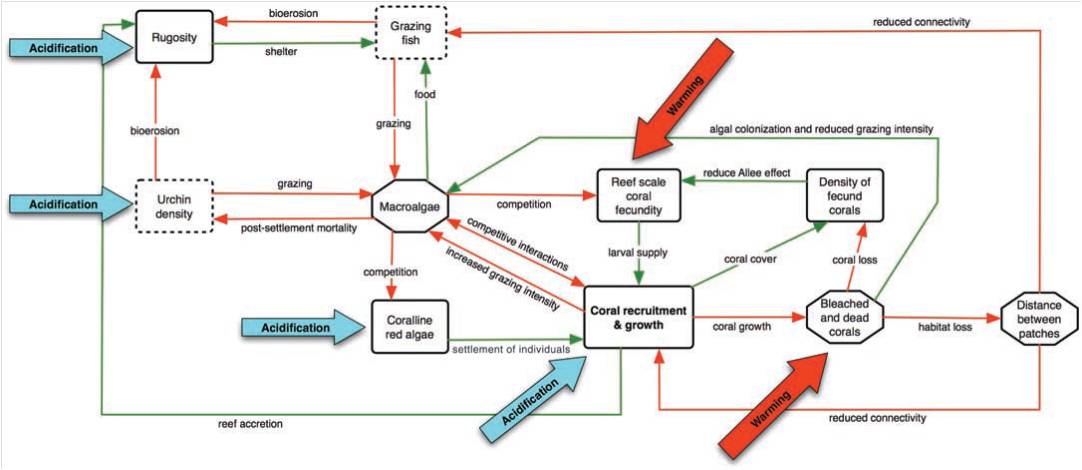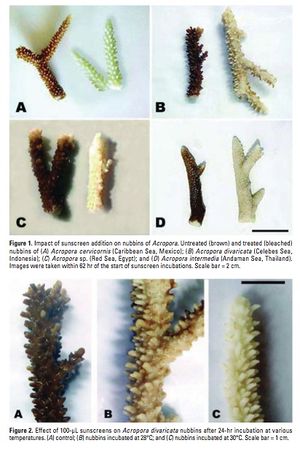Bleaching
Coral Bleaching
What is bleaching?
Simply, it is the release of coral symbiotic zooxanthellae . A more depth definition is the loss of all or some symbiotic algae and photosynthetic pigments by the coral animal resulting in their white calcium carbonate skeleton becoming visible through the now translucent tissue layer making them appear white or ‘bleached’ of their original color [1]
- Corals and symbiotic relationship
- What are zooxanthellae? - Dinoflagellates that live in coral tissues
- What they do/importance? – photosynthesis, CO2 removal
- Expulsion of zooxanthellae – give corals color, they now appear white
Causes
- SST
- Stress on corals
- Affects on symbiotic relationship
- Past, present, and future predictions/ frequency of bleaching events [2]
- Acidification
- What is acidification? – CO2 dissolves in ocean and increases acidity which dissolves CaCO3
- Impact of acidification on bleaching – increases bleaching events
- Synergy with SST – higher SST amplifies acidification effects and bleaching
- Stress
- Types
- Elevated temperature
- High solar irradiance
- Disease
- Hostile/changing environment
- Disruption of symbiotic relationship
- Why expel zooxanthellae?
- Types
 NOAA Coral Reef Watch near- real-time satellite from 2205 showing a.SST b.SST anomalies c.coral bleaching HotSpots d. coral bleaching Degree Heating Weeks[1]
NOAA Coral Reef Watch near- real-time satellite from 2205 showing a.SST b.SST anomalies c.coral bleaching HotSpots d. coral bleaching Degree Heating Weeks[1]
Effects
- Disease – frequency increases
- Ecosystem/reef effects
- Corals – productivity, recruitment, survivability/adaptation
- Fish/Other organisms – habitat, recruitment, abundance

Special Case Study
- US Virgin Islands following bleaching in 2005
- Showed a correlation between temperature and disease from the 2005 massive bleaching of the coral. The deaths continued even when temperatures went down in future years due to the initial high stress.[3]
- Sunscreen and reefs
- Through laboratory experiments, it was determined that sunscreens cause complete and rapid bleaching of hard corals, even at extremely low concentrations. This negative effect is the result of organic ultraviolet filters, which are able to produce the lytic viral cycle in symbiotic zooxanthellae. By fostering viral infection, sunscreens could play a large role in coral bleaching in areas exposed to high levels of human recreation.[4]
 An example of bleached coral due to the effects of sunscreen. [4]
An example of bleached coral due to the effects of sunscreen. [4]
What we are currently doing to sustain coral ecosystems
- USGS “Science Based Strategies” example
- Coral reefs are necessary in supporting many different ecosystems
- Although threats are known, there are still strides that need to be made in how scientists respond to them and how we treat and/or prevent the current problems and threats such as carbon sequestration, ocean temp, ocean acidification, sea level rise, atmospheric dust, land-derived impacts, pathogens and disease, overfishing and ecological integrity [5]
Notes
- ↑ 1.0 1.1 H. van Oppen, M. J., & Lough, J. M. (2009). Coral bleaching: Patterns, processes, causes and consequences. (Vol. 205). Springer Berlin Heidelberg. Retrieved from http://link.springer.com/book/10.1007/978-3-540-69775-6/page/1
- ↑ Hoegh-Guldberg, Ove (1999) . Climate change, coral bleaching and the future of the world's coral reefs. Marine and Freshwater Research 50 , 839–866.
- ↑ USGS. (2008, June). Coral diseases following massive bleaching in 2005 cause 60 percent decline in coral cover and mortality of the threatened species, acropora palmata, on reefs in the u.s. virgin islands. Retrieved from http://pubs.usgs.gov/fs/2008/3058/pdf/fs2008-3058.pdf
- ↑ 4.0 4.1 Danovaro, R., Bongiorni,, L., Corinaldesi, C., Giovannelli, D., Pusceddu, A., Damiani, E., Astolfi, P., & Greci, L. (2008). Sunscreens cause coral bleaching by promoting viral infections. Environmental Health Perspectives, 116(4), 441-447.
- ↑ USGS. (2008, September). Science-based strategies for sustaining coral ecosystems. Retrieved from http://pubs.usgs.gov/fs/2009/3089/pdf/brewercoralfs3.pdf
T. Tyrrell (2007). Calcium Carbonate Cycling in Future Oceans and its Influence on Future Climates.
K. R. N. Anthony, et al. (2008). Ocean acidification causes bleaching loss in coral reef builders. PNAS vol. 105 no. 45
O. Hoegh-Guldberg, et al. (2007). Coral Reefs Under Rapid Climate Change and Ocean Acidification. Science 318, 1737